Caterpillars, the larval stage of moths and butterflies, are an important part of our natural world. These fascinating creatures draw our attention with their diverse colors, shapes, and patterns. Here, we explore 29 caterpillars you might come across in the state of Minnesota, seven of which are poisonous. But first, let’s get a little background knowledge to better appreciate these wonders of nature.
The Transformation Journey
Caterpillars undergo an amazing change known as metamorphosis, a process that sees them morph from crawling larvae into winged moths or vibrant butterflies. This journey begins with the caterpillar hatching from an egg, followed by a growth phase where it feeds voraciously on plants. After a series of molts, the caterpillar forms a chrysalis or cocoon, within which it has a profound change, emerging as an adult winged insect.
Moths vs. Butterflies
While both moths and butterflies start as caterpillars, they exhibit differences that set them apart from one another:
Moths: Typically nocturnal, moths often have drab colors, feathery antennae, and a stout body. Their caterpillars may have distinctive hair-like structures and can be found in a variety of habitats.
Butterflies: Usually active during the day, butterflies are often brightly colored with clubbed antennae. Their caterpillars may be more smooth and are often found with specific host plants.
Caterpillars Around the World
The diversity of caterpillars shows the vast array of moths and butterflies they become:
Worldwide
There are around 160,000 known species of moths and butterflies around the world.
North America
Here, there are over 11,000 species, so a wide variety of caterpillars adapted to different ecosystems.
Minnesota
With its diverse landscapes, Minnesota is home to nearly 1,000 species of caterpillars that have found homes in the state’s rich and varied ecosystems. According to the Minnesota Department of Natural Resources, the state hosts 800 moth caterpillar species and 140 butterfly caterpillar species.
Ecological Roles
Caterpillars’ importance extends beyond their appearance. Indeed, they play vital roles in ecosystems:
Herbivores: They feed on plants, helping to control plant growth.
Prey: They are a crucial food source for birds, mammals, and other insects.
Pollinators: Some adult moths and butterflies contribute to pollination.
Caterpillars are more than just future moths or butterflies that are fun to look at. They are dynamic organisms that contribute to the complexity and balance of nature. Their existence enriches our ecosystems, offering opportunities for scientific study, ecological understanding, and simple wonder and awe at their transmogrifications. Whether in the forests of Minnesota or the diverse habitats around the globe, caterpillars continue to mystify and inspire, highlighting the interconnectedness of life on our planet.
7 Poisonous Caterpillars Found in Minnesota

American Dagger
©karan kiruba/Shutterstock.com
1. American Dagger Moth (Acronicta americana)
Description: Pale green caterpillar with white or pale yellow hair-like outgrowths. Feeds on woody plants.
Toxicity: Covered in toxic barbed lashes that can cause stinging, burning, and a rash.
Regions & Climate: Found in deciduous woodlands and forests across Minnesota.

Io
©Donna Bollenbach/Shutterstock.com
2. Io Caterpillar (Automeris io)
Description: Green with red and white stripes, the Io Caterpillar has a striking appearance. It feeds primarily on hackberry and willow trees, and its venomous spines can deliver a painful sting.
Regions & Climate: Widespread in the eastern and central United States, including Minnesota. It is found in various habitats, including woodlands and gardens.
Toxicity: Highly venomous, and its sting can be painful. Caution is advised when encountering this caterpillar.
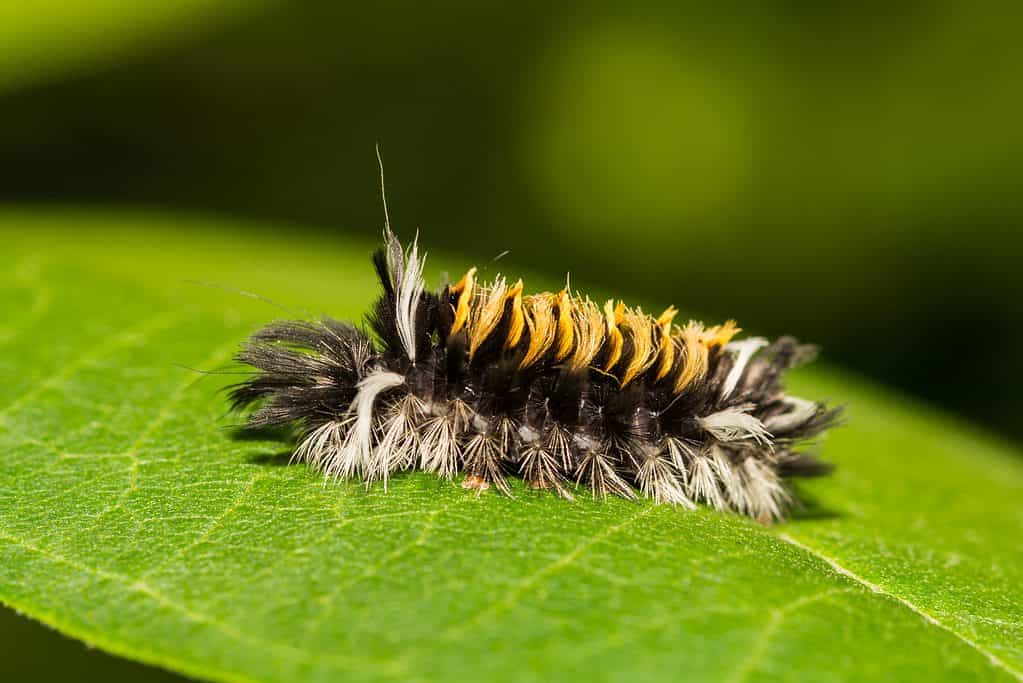
Milkweed Tussock
©Jay Ondreicka/Shutterstock.com
3. Milkweed Tussock Caterpillar (Euchaetes egle)
Description: Covered in black and white hairs with eye-catching orange tufts, this caterpillar feeds exclusively on milkweed. It stores a poisonous chemical called cardiac glycoside, making it unappealing to predators.
Regions & Climate: Found throughout the eastern and central United States, including Minnesota. It is commonly found in meadows, fields, and areas where milkweed plants grow.
Toxicity: Considered toxic due to the storage of cardiac glycoside. While not harmful to touch, it can be dangerous if eaten by certain predators. Keep pets and small children away!
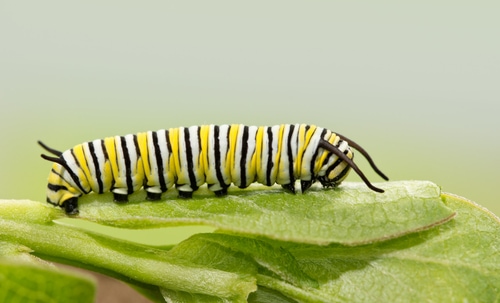
Famous monarch
©Sari ONeal/Shutterstock.com
4. Monarch Caterpillar (Danaus plexippus)
Description: Distinctive appearance, toxic due to milkweed diet. Migratory butterfly.
Climate: Meadows, fields, and areas with milkweed.
Regions: Widespread across Minnesota.
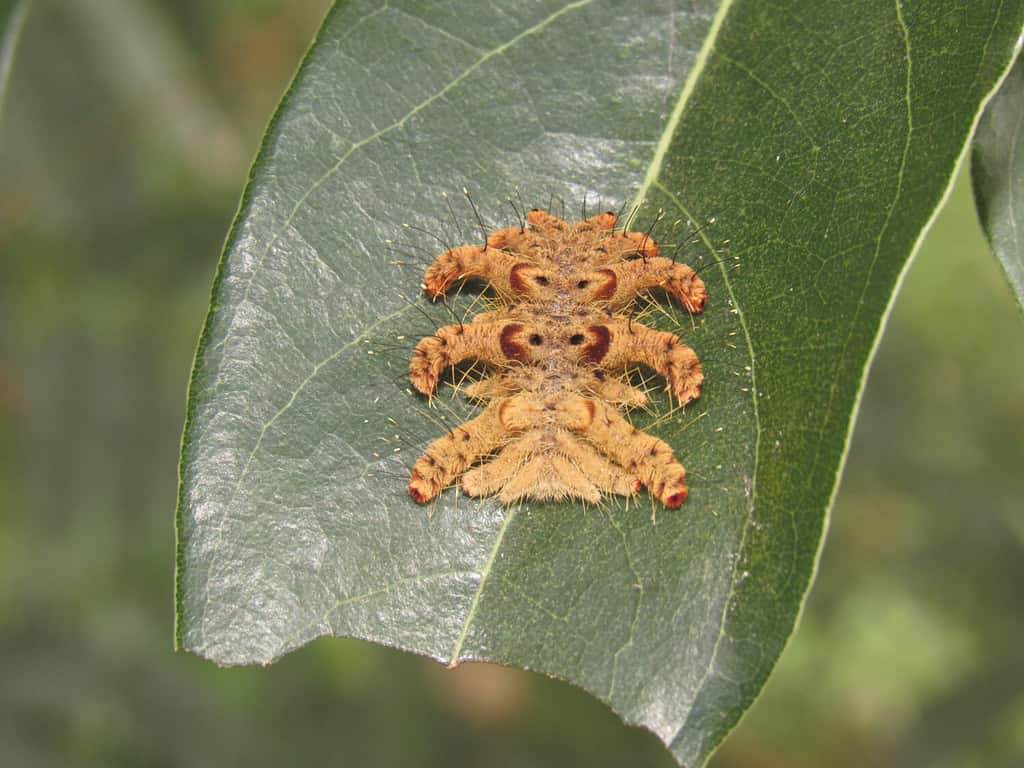
The monkey slug is also known as the hag moth.
©Fabio Ara/Shutterstock.com
5. Monkey Slug (Phobetron pithecium)
Description: The monkey slug is a unique and bizarre looking caterpillar. It’s tan to brown in color with fourteen leg-like projections. Its appearance often resembles a hairy spider. It feeds on a variety of woody-stemmed plants or trees and has a contorted shape that aids in camouflage.
Regions & Climate: Found across the eastern United States, including Minnesota, the monkey slugs thrives in forested areas and places where its host plants are abundant.
Toxicity: While not highly toxic, the bristles on the Monkey Slug can embed in the skin and cause a mild rash and itching. Caution is advised when handling or viewing this caterpillar.
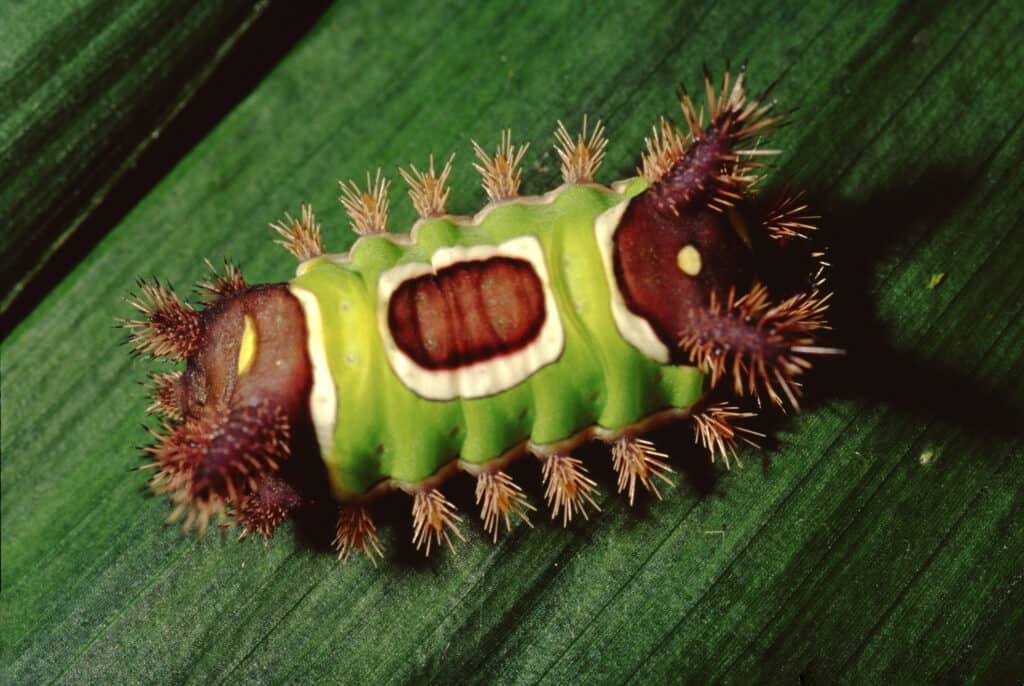
The Saddleback Caterpillar’s brown “saddle” can still be seen even after it transforms into a moth.
©Liz Weber/Shutterstock.com
6. Saddleback Caterpillar (Acharia stimulea)
Description: Green with a distinctive brown “saddle.” Toxic hairs cause skin irritation.
Climate: Woodlands and gardens.
Regions: Rare in Minnesota, more common in the southeastern United States.

Named like it sounds, white-marked
©Satyashutter/Shutterstock.com
7. White-Marked Tussock Caterpillar (Orgyia leucostigma)
Description: With black and yellow stripes and tufts of hair-like spines, this caterpillar has a distinctive appearance. It feeds on nearly any tree, and its hairs can cause a rash. Population outbreaks are sometime occur, leading to noticeable defoliation.
Regions & Climate: Found throughout the eastern United States, including Minnesota, in forests, woodlands, and urban areas with trees.
Toxicity: The hairs can cause a rash if they come into contact with the skin, so use caution when observing these fuzzy-looking little ones.
22 Non-Toxic Caterpillars Found in Minnesota

Intriguing indeed, the Abbott’s Sphinx presents an elegant profile.
©Jay Ondreicka/Shutterstock.com
8. Abbott’s Sphinx (Sphecodina abbottii)
Description: Larvae mimic woody vines, adults resemble broken branches. Feeds on grapevines and Virginia creeper.
Regions & Climate: Found in fields and woodlands across Minnesota, active day and night.
Toxicity: Non-toxic and not harmful to humans.
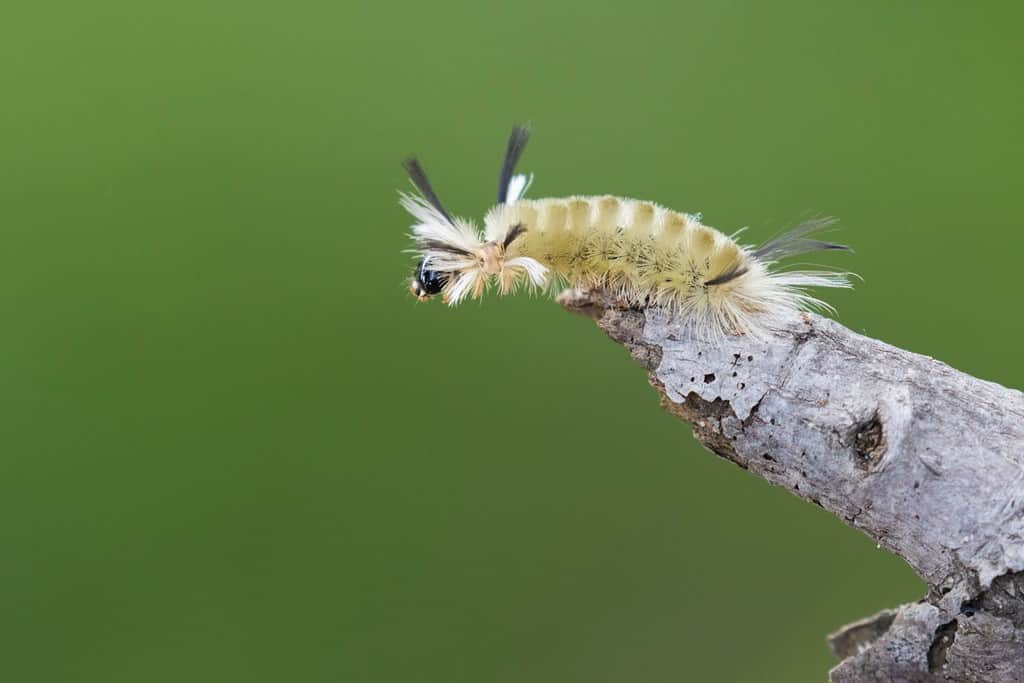
The Banded Tussock appears as though it was, well, banded near its eyes.
©Mircea Costina/Shutterstock.com
9. Banded Tussock Caterpillar (Halysidota tessellaris)
Description: Pale cream, yellow, or light brown in color. Black tufts on head and rear end, adorned with hair-like bristles.
Regions & Climate: Throughout North America, including Minnesota. Deciduous forests and wooded areas.
Toxicity: Non-toxic and not harmful to humans.

The Blinded Sphinx is mesmerizing to behold.
©christine123 / CC BY 4.0 – License
10. Blinded Sphinx (Paonias excaecata)
Description: Adult moth with blue eyespot on pink hindwing. Bright green caterpillar found from May to November.
Regions & Climate: Open deciduous forests and woodlands across Minnesota.
Toxicity: Non-toxic and not harmful to humans.
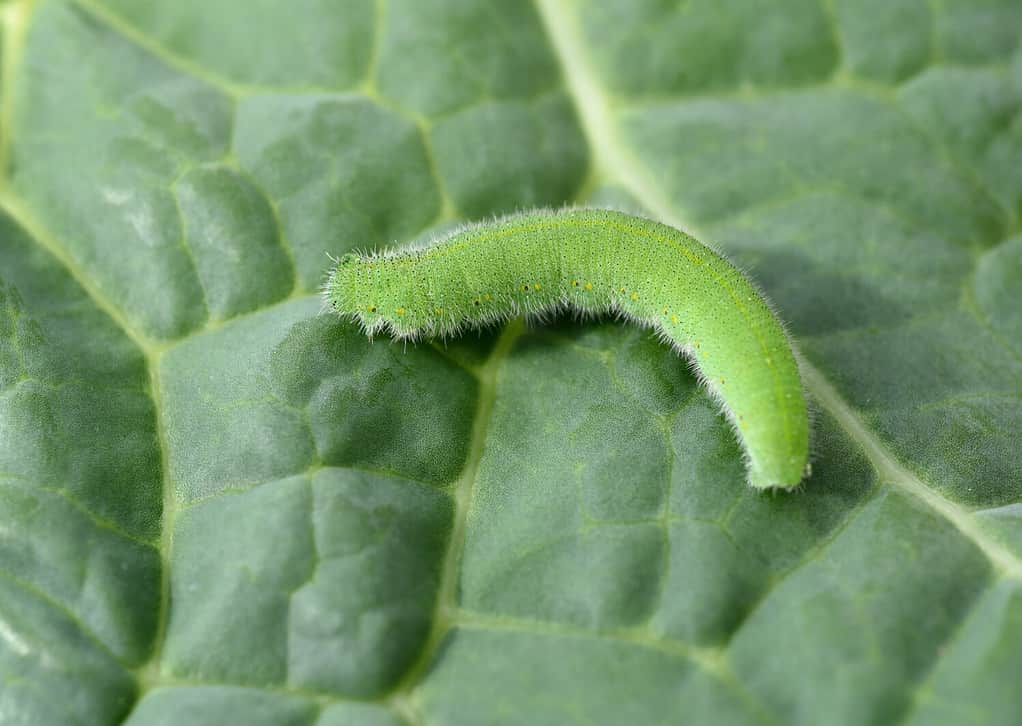
As cute as it sounds, the Cabbage White eats cabbage.
©Manfred Ruckszio/Shutterstock.com
11. Cabbage White Caterpillar (Pieris rapae)
Description: Greenish, often found on cabbage and other cruciferous plants.
Regions & Climate: Statewide in Minnesota, especially in areas with vegetable gardens.
Toxicity: Non-toxic and not harmful to humans.

Colorful and bristly, the Cecropia gives grows up to be come our continent’s largest moth.
©K Hanley CHDPhoto/Shutterstock.com
12. Cecropia Moth Caterpillar (Hyalophora cecropia)
Description: North America’s largest native moth. Colorful caterpillars with fascinating tubercles.
Regions & Climate: Throughout Minnesota, especially in deciduous forests, parks, and suburban areas.
Toxicity: Non-toxic and not harmful to humans.

Very curved, this caterpillar is easily mistaken for a dry leaf.
©Judy Gallagher / CC BY 2.0 – License
13. Curve-Lined Owlet Moth Caterpillar (Phyprosopus callitrichoides)
Description: They are brown and cream in color, prickly, and imitate a dry leaf. It eats greenbriers.
Regions & Climate: Expert at camouflage, found in wooded regions of Minnesota.
Toxicity: Non-toxic and not harmful to humans.
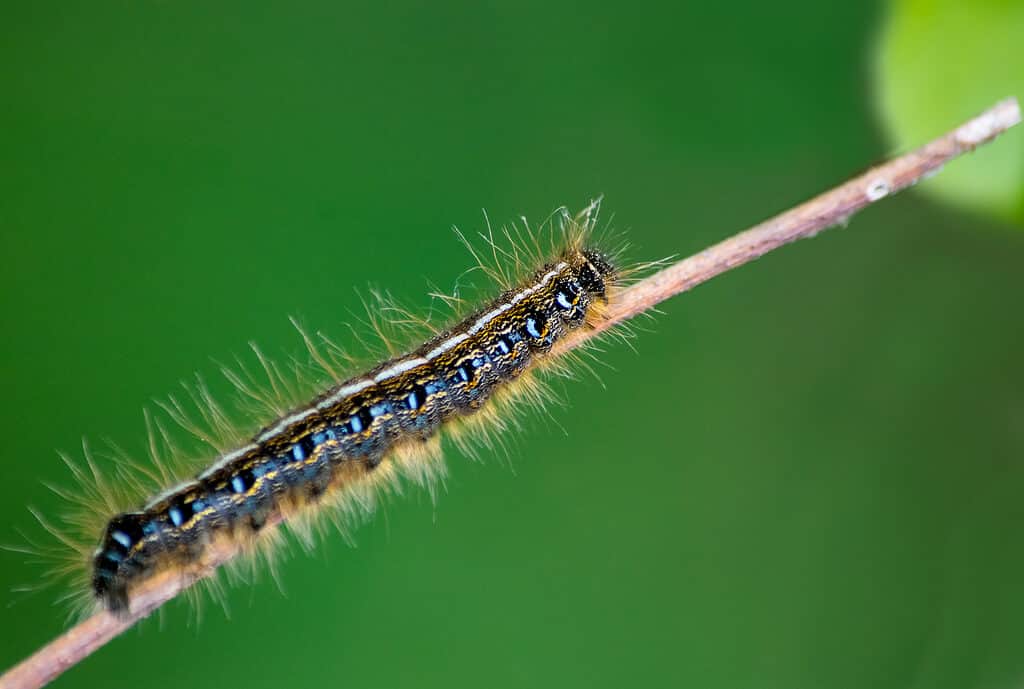
The Eastern Tent
©K Quinn Ferris/Shutterstock.com
14. Eastern Tent Caterpillar (Malacosoma americanum)
Description: Known for tent-like nests in trees. Feeds on deciduous trees.
Regions & Climate: Common in wooded areas across Minnesota.
Toxicity: Non-toxic and not harmful to humans.
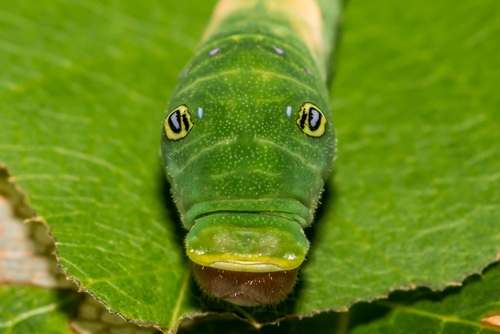
Snakelike, the Eastern
Tiger
is a fan of tulips and cherries, among other things.
©Jay Ondreicka/Shutterstock.com
15. Eastern Tiger Swallowtail Caterpillar (Papilio glaucus)
Description: Bright green with large eye spots, mimics a snake’s head. Feeds on tulip trees and wild black cherries.
Regions & Climate: Widespread in eastern North America, including Minnesota. Thrives in deciduous forests and woodland edges.
Toxicity: Non-toxic and not harmful to humans.

The Forest Tent, while pleasant to look at, can be harmful to trees during outbreaks.
©jcohen9/Shutterstock.com
16. Forest Tent Caterpillar (Malacosoma)
Description: Known for outbreaks leading to widespread leaf loss on deciduous trees.
Regions & Climate: Native to most of the United States, including Minnesota, especially in northern regions.
Toxicity: Non-toxic and not harmful to humans.
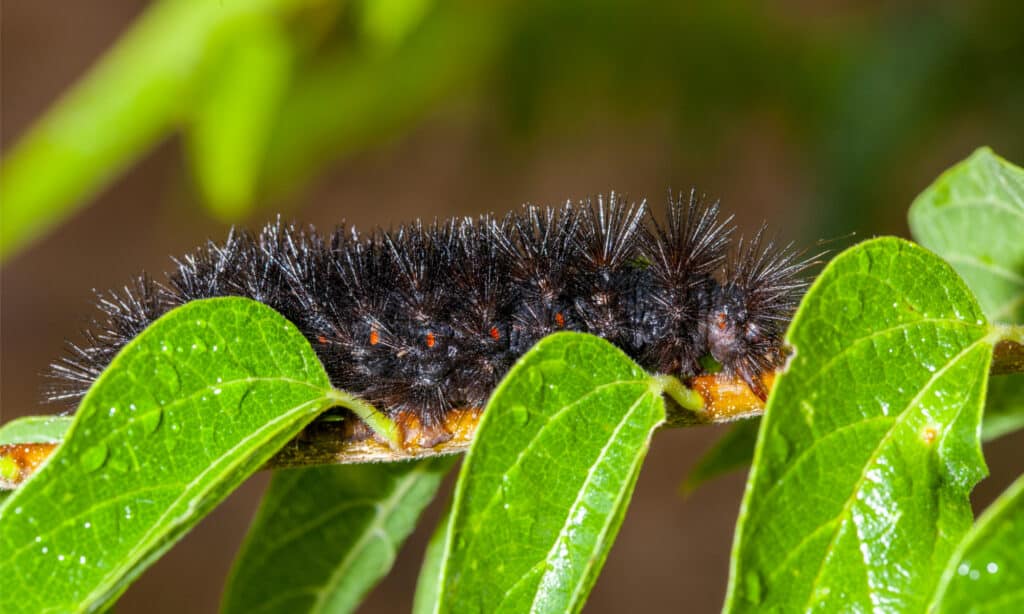
Giant
leopard
moth caterpillar, black and bristly.
©iStock.com/Eblis
17. Giant Leopard Moth Caterpillar (Hypercompe scribonia)
Description: Covered in black bristles with red rings, feeds on various plants.
Regions & Climate: Distributed across the eastern United States, including Minnesota. Various habitats from forests to gardens.
Toxicity: Non-toxic but may cause irritation if handled roughly.
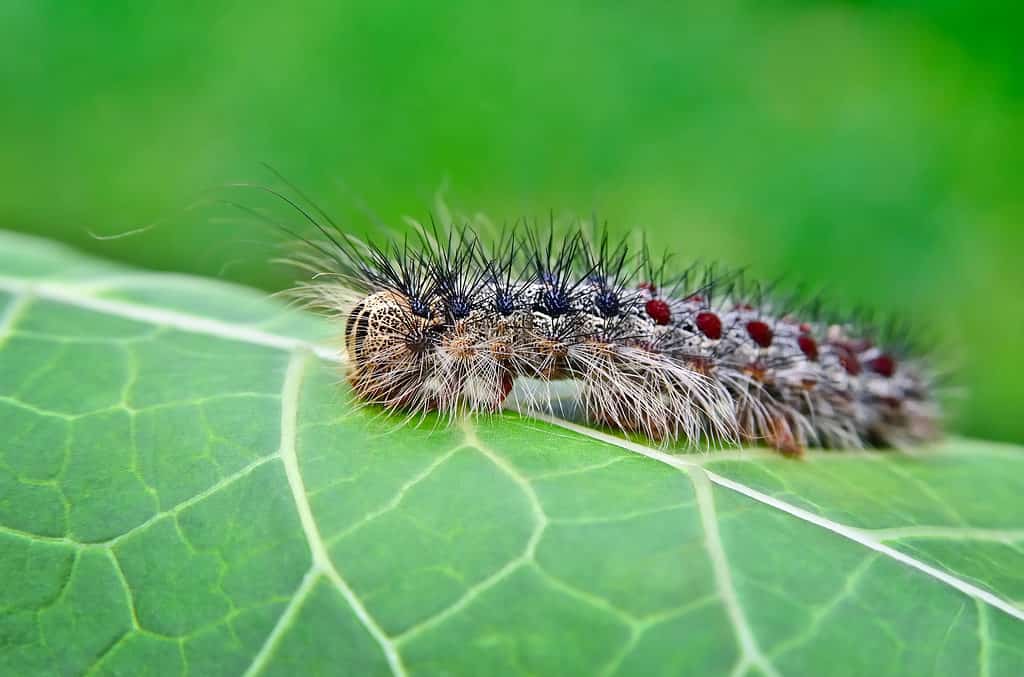
Widely known in its moth form
©Oleksandrum/Shutterstock.com
18. Gypsy Moth Caterpillar (Lymantria dispar)
Description: Hairs may cause irritation. Known for defoliating trees.
Regions & Climate: Found in many parts of Minnesota, particularly in the northeast.
Toxicity: Hairs can irritate skin; caution advised.
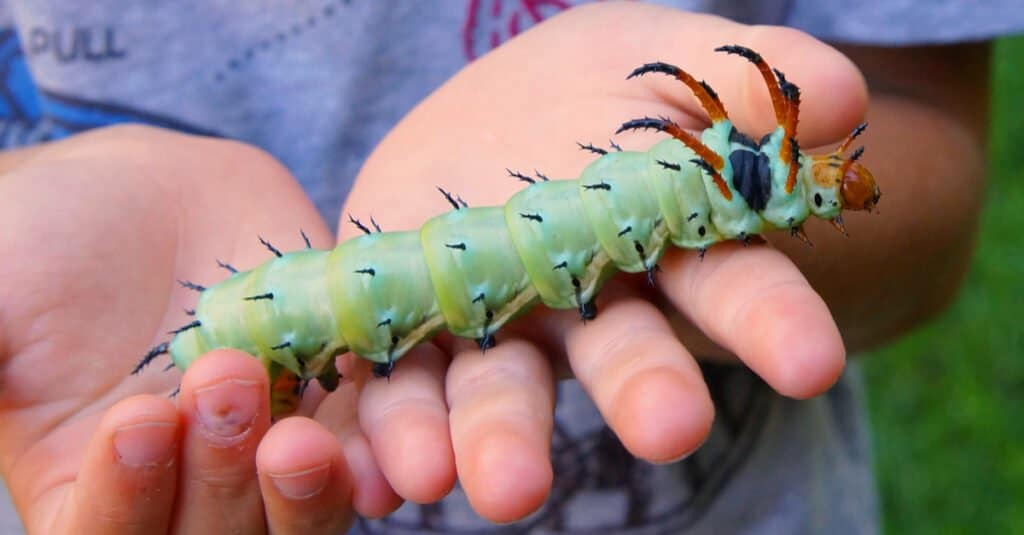
Though not dangerous to humans, the Hickory Horned Devil uses its horns against predators.
©Matt Jeppson/Shutterstock.com
19. Hickory Horned Devil (Citheronia regalis)
Description: Fearsome appearance but harmless. Bright green with large horns.
Regions & Climate: Rare in Minnesota, more common in southern states. Woodlands with host trees.
Toxicity: Non-toxic and not harmful to humans.
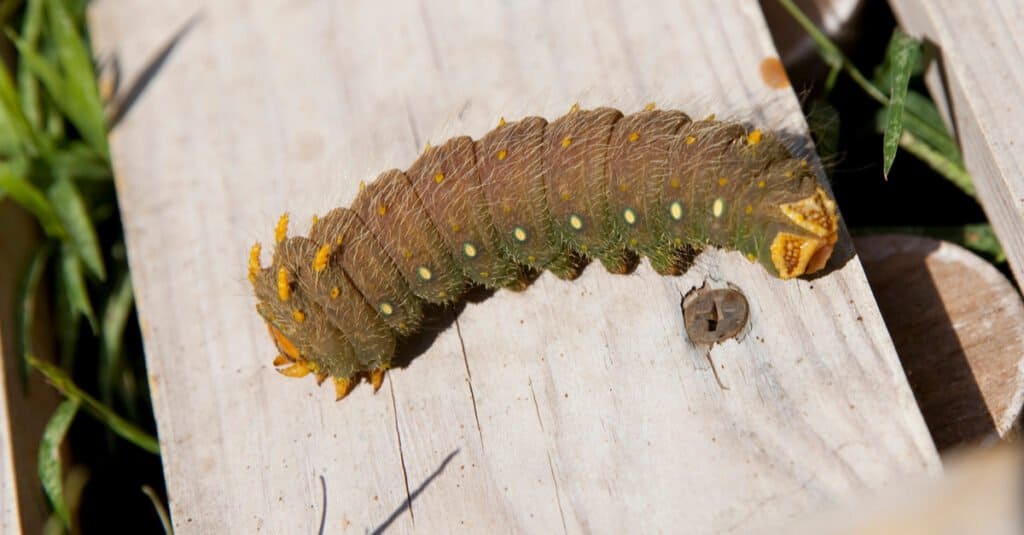
As far as caterpillars go, the Imperial is big.
©Jeanne Raises/Shutterstock.com
20. Imperial Moth Caterpillar (Eacles imperialis)
Description: Large, colorful caterpillar that feeds on various trees.
Regions & Climate: Found throughout Minnesota, especially in forested regions.
Toxicity: Non-toxic and not harmful to humans.
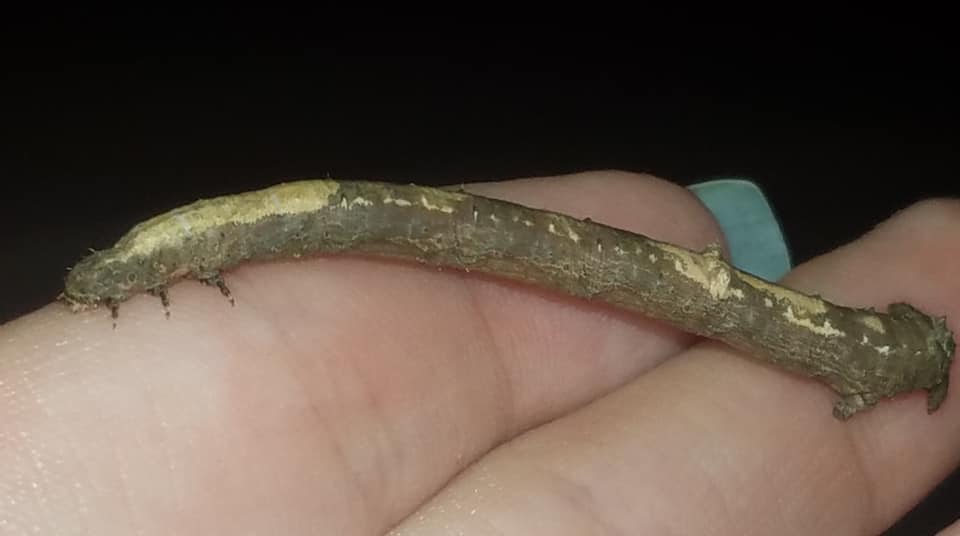
Looks like a twig, but isn’t.
©Andy Reago & Chrissy McClarren / Flickr – License
21. Large Maple Spanworm (Prochoerodes lineola)
Description: Gray-brown with a bark-like pattern, looks like a twig. Various host plants and trees.
Regions & Climate: Found across Minnesota, especially in wooded areas.
Toxicity: Non-toxic and not harmful to humans.

Spurge Hawk Moth caterpillar
©Eric Isselee/Shutterstock.com
22. Leafy Spurge Hawkmoth Caterpillar (Hyles euphorbiae)
Description: Brightly colored with distinct markings, feeds on leafy spurge plants. Mature into a large exotic moth with brown body and olive-brown wing patches.
Regions & Climate: Introduced to the U.S., now found in various regions, including Minnesota.
Toxicity: Non-toxic and not harmful to humans.
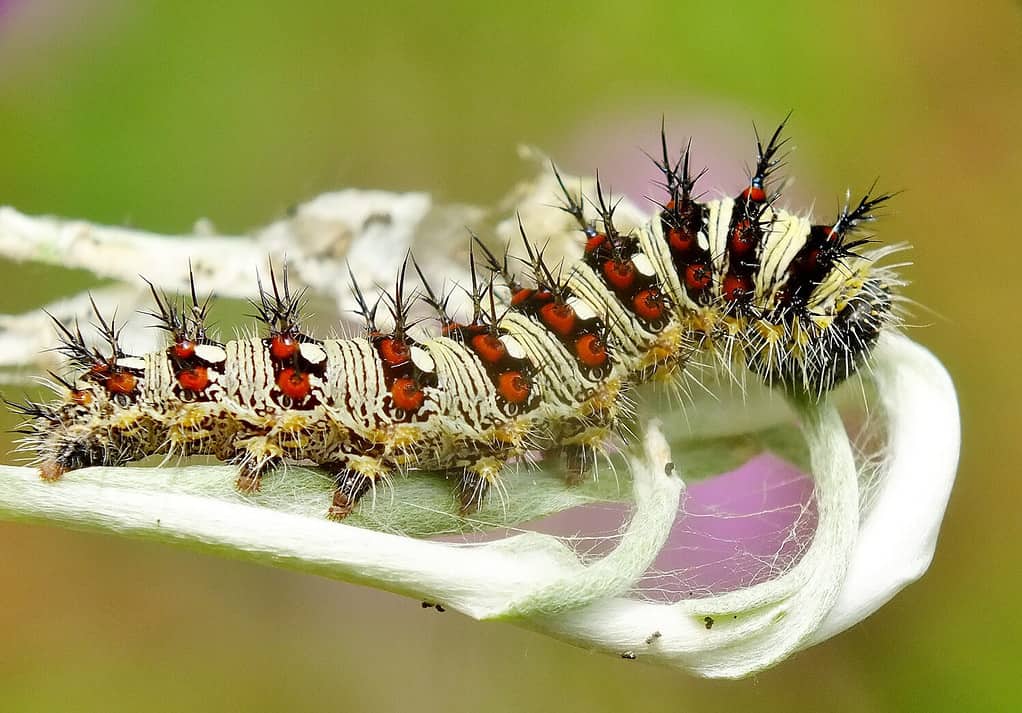
Intricate and rather fancy-looking, the Painted Lady is a joy to look at.
©AnaGoncalves93/Shutterstock.com
23. Painted Lady Butterfly (Vanessa cardui)
Description: Migratory species with distinct summer and winter forms. Caterpillar form can be various colors.
Regions & Climate: Widespread, has migration cycles in Minnesota.
Toxicity: Non-toxic and not harmful to humans.
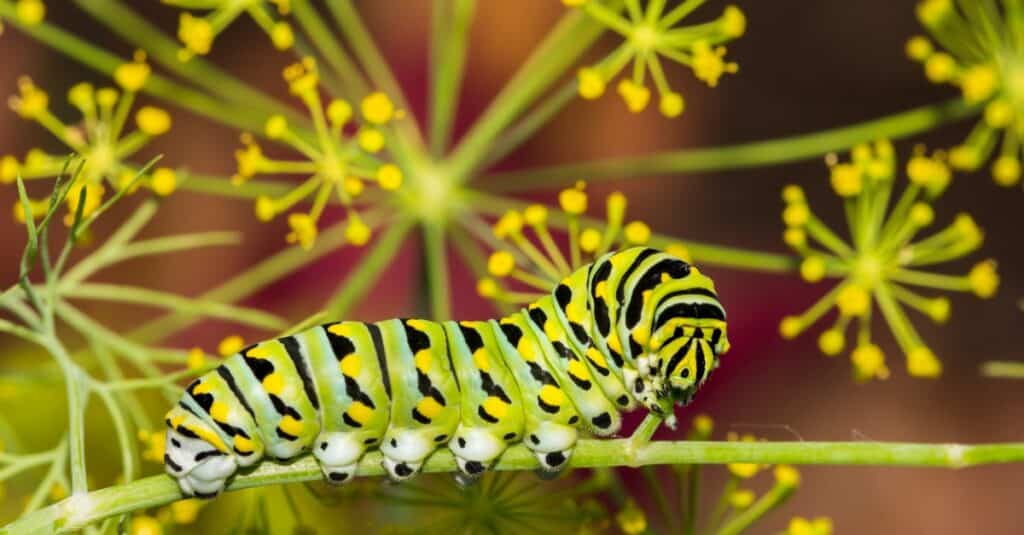
You are what you eat
©Jay Ondreicka/Shutterstock.com
24. Parsley Caterpillar (Black Swallowtail) (Papilio polyxenes)
Description: Bright green with black and yellow dots, feeds on parsley plants. Larva of the Black Swallowtail butterfly.
Regions & Climate: Widespread across North America, including Minnesota. Found in gardens, meadows, and host plant areas.
Toxicity: Non-toxic and not harmful to humans.

Soft to the touch, the Spotted Apatelodes Caterpillar is fortunately not toxic.
©Jacy Lucier / CC BY-SA 4.0 – License
25. Spotted Apatelodes Caterpillar (Apatelodes torrefacta)
Description: Bright white to lemon yellow, covered in soft, downy hairs. Feeds on ash, maple, and oak trees.
Regions & Climate: Eastern United States, including Minnesota. Thrives in deciduous forests and woodlands.
Toxicity: Non-toxic and not harmful to humans.

Fritillary
©Brett Hondow/Shutterstock.com
26. Variegated Fritillary Caterpillar (Euptoieta claudia)
Description: Striped with black, red, and white, feeds on plants in the violet or alder family. Chrysalis looks like a jeweled pendant.
Regions & Climate: Across North and Central America, including Minnesota. Found in open fields, meadows, and prairies.
Toxicity: Non-toxic and not harmful to humans.

The Viceroy resembles guano.
©Malachi Jacobs/Shutterstock.com
27. Viceroy Caterpillar (Limenitis archippus)
Description: Mottled brown or green and white, resembles bird droppings. Feeds on willow, poplar, and cottonwood trees.
Regions & Climate: Widespread across Minnesota, found in areas with host trees.
Toxicity: Non-toxic and not harmful to humans.

The Tent caterpillars work together to create “tents.”
©Wirestock Creators/Shutterstock.com
28. Western Tent Caterpillar Moth (Malacosoma californicum)
Description: Common in the western US with isolated populations in Minnesota. Variable color pattern.
Regions & Climate: Isolated areas in northern Minnesota, feeds on trees and shrubs.
Toxicity: Non-toxic and not harmful to humans.
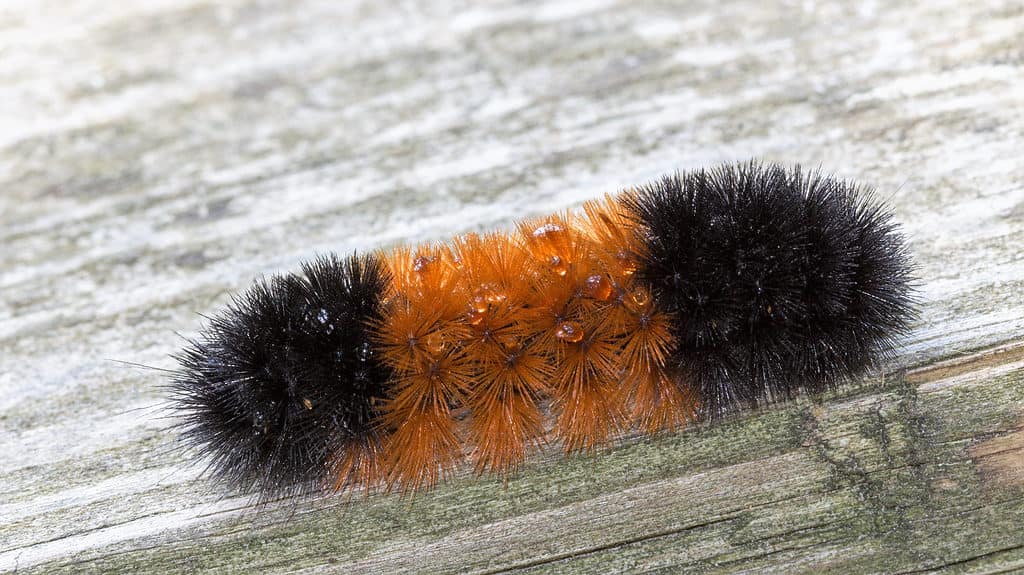
Not a bear, but definitely woolly.
©Kimberly Boyles/Shutterstock.com
29. Woolly Bear (Pyrrharctia isabella)
Description: Fuzzy appearance. Folklore links their appearance to winter weather predictions.
Regions & Climate: Common throughout Minnesota in various habitats including fields, gardens, and roadsides.
Toxicity: Non-toxic and not harmful to humans.
Regions of Minnesota with Most Caterpillars and Why
Minnesota’s varied climate and diverse ecosystems provide a favorable environment for many species of caterpillars, including those mentioned above. Here’s a breakdown of the regions and why they host a rich variety of caterpillars:
1. Deciduous Forests and Woodlands
Caterpillars Found Here: American Dagger Moth, Blinded Sphinx, Abbott’s Sphinx, Viceroy Caterpillar, Large Maple Spanworm, and others.
Why: These areas are rich in diverse plant species, offering a wide variety of food sources for caterpillars. The dense foliage offers protection from predators.
2. Wetlands and Marshy Areas
Caterpillars Found Here: Those that feed on willow, poplar, and other water-loving plants, such as the Viceroy Caterpillar.
Why: Wetlands provide specific plants that some caterpillars need for food. These areas also offer moisture needed for the development of certain species.
3. Prairies and Open Fields
Caterpillars Found Here: Abbott’s Sphinx, Painted Lady Butterfly, Variegated Fritillary Caterpillar, and others.
Why: Prairies offer a surfeit of wildflowers and grasses that cater to species adapted to open and sunlit environments.
4. Northern Regions
Caterpillars Found Here: Western Tent Caterpillar Moth, Io Caterpillar, and others.
Why: Certain caterpillars are adapted to cooler climates found in the northern regions of Minnesota. Isolated populations might develop unique characteristics.
5. Urban and Suburban Areas
Caterpillars Found Here: Cabbage White Caterpillar, Parsley Caterpillar (Black Swallowtail), and others that feed on garden plants.
Why: Gardens and landscaped areas offer specific plants that attract certain caterpillars. These regions might host species that have adapted to human-altered environments.
6. Mixed Forests with Coniferous Trees
Caterpillars Found Here: Eastern Tent Caterpillar, Forest Tent Caterpillar, and others.
Why: Mixed forests provide diverse food sources, and the presence of coniferous trees supports species that feed on needles and other unique plant parts.
Conclusion
Minnesota’s diverse landscapes, ranging from dense forests to open prairies, wetlands, coniferous forests, and human-made environments, make possible the rich array of caterpillars. The state’s varied climate and topography provide perfect ecological pockets that cater to the specific needs and preferences of various species.
Understanding the distribution and behavior of caterpillars in Minnesota provides insights into the state’s ecological health and diversity. It also helps in the conservation of these fascinating creatures and the essential roles they play in ecosystems, such as pollination and serving as a food source for other wildlife. So next time you’re out and about, whether in the city, suburbs, or wilderness, take a closer look—you might just spot one of nature’s greatest shapeshifters in its larval stage, munching away at some plant.
Summary Table of Caterpillars
| Name | Description | Toxicity |
|---|---|---|
| Abbott’s Sphinx | Found in fields and woodlands | No |
| American Dagger Moth | Toxic, causes stinging and burning | Yes |
| Banded Tussock Caterpillar | Pale with black tufts | No |
| Blinded Sphinx | Large moth, green caterpillar with horn | No |
| Cabbage White Caterpillar | Found on cabbage | No |
| Cecropia Moth Caterpillar | Largest North American moth | No |
| Curve-Lined Owlet Moth Caterpillar | Resembles dry leaf | No |
| Eastern Tent Caterpillar | Very social for larvae | No |
| Eastern Tiger Swallowtail Caterpillar | Green, large eyespots | No |
| Forest Tent Caterpillar | Safe to touch | No |
| Giant Leopard Moth Caterpillar | Black bristles, feeds on various plants | No |
| Gypsy Moth Caterpillar | May cause irritation | No |
| Hickory Horned Devil | Looks fearsome but safe | No |
| Imperial Moth Caterpillar | Non-toxic | No |
| Io Caterpillar | Highly venomous, painful sting | Yes |
| Large Maple Spanworm | Bark-like pattern, excellent camouflage | No |
| Leafy Spurge Hawkmoth | Introduced species, feeds on spurge plants | No |
| Milkweed Tussock Caterpillar | Black and white, feeds on milkweed | Yes |
| Monarch Caterpillar | Toxic due to milkweed diet | Yes |
| Monkey Slug | Resembles hairy spider, mild rash | Yes |
| Painted Lady Butterfly | Migratory, variable caterpillar, not harmful | No |
| Parsley Caterpillar (Black Swallowtail) | Green, feeds on parsley | No |
| Saddleback Caterpillar | Toxic, causes skin irritation | Yes |
| Spotted Apatelodes Caterpillar | White to yellow, soft hairs | No |
| Variegated Fritillary Caterpillar | Striped, feeds on violet family | No |
| Viceroy Caterpillar | Resembles bird droppings, feeds on willow | No |
| Western Tent Caterpillar Moth | Variable color | No |
| White-Marked Tussock Caterpillar | Striped, may cause a rash | Yes |
| Woolly Bear | May cause mild rash, but non-toxic | No |
The photo featured at the top of this post is © Michael Siluk/Shutterstock.com
Thank you for reading! Have some feedback for us? Contact the AZ Animals editorial team.






